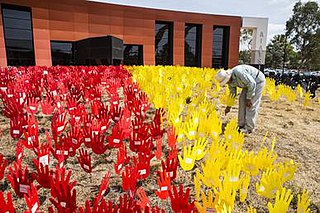Country
Norman Tindale estimated their tribal grounds as extending over abourt 7,800 square miles (20,000 km2). The Wurlu occupied the northern side of the King Leopold Range. They lay east of the Isdell Range, and their reach extended northwards as far as the Phillips Range and the headwaters of the Hann and upper Fitzroy rivers. To the east, their territory ran up to Bluff Face Range, in a line that linked directly Elgee Cliffs and the Burramundy Range. According to information gathered by Joseph Birdsell, the Wurla in penetrated down the Chapman and Durack rivers to Karunjie severed the traditional links between the Ngarinjin and Gija.

Norman Barnett Tindale AO was an Australian anthropologist, archaeologist, entomologist and ethnologist.

The King Leopold Ranges are a range of hills in the western Kimberley region of Western Australia. The range was named on 6 June 1879 by the explorer Alexander Forrest, during an expedition in the Kimberley area, after King Leopold II of Belgium, "for the great interest taken by His Majesty in exploration".
Isdell River is a river in the Kimberley region of Western Australia, named in 1898 by explorer Frank Hann after James Isdell, who was prominent in the region and later served as a member of parliament.
This page is based on this
Wikipedia article Text is available under the
CC BY-SA 4.0 license; additional terms may apply.
Images, videos and audio are available under their respective licenses.

The Bunuba are a group of Indigenous Australians and are one of the traditional owners of the southern West Kimberley, in Western Australia. Many now live in and around the town of Fitzroy Crossing.
The Niabali, otherwise written Nyiyaparli, are an indigenous Australia tribe of the Pilbara region of Western Australia.
The Miriwung are an indigenous Australian people of the Kimberley region of northern Western Australia.
The Umiida, also written Umede, were an indigenous Australian people of the Kimberley region of north Western Australia.
The Gooniyandi, also known as the Konejandi, are an indigenous Australian people of Western Australia.
The Maduwongga are an indigenous Australian people of Western Australia.
The Bailgu are an indigenous Australian people of the Pilbara region of Western Australia.
The Panyjima are an indigenous people of the Pilbara region of Western Australia.
The Miwa are an indigenous Australian people of the Kimberley region of Western Australia.
The Yeidji, otherwise commonly known as the Gwini, are an indigenous Australian people of the Kimberley area of Western Australia.
The Kambure more commonly known now as Gamberre,were an indigenous Australian people of the Kimberley region of Western Australia.
The Unggarranggu, also traditionally transcribed as Ongkarango, are an indigenous Australian people of Western Australia.
The Unggumi, also written Ongkomi, are an indigenous Australian people of the Kimberley region of Western Australian.
The Doolboong, also known as Duulngari, were an indigenous Australian people of the Northern Territory and northeast Western Australia.
The Ngombal, also known as the Ngumbarl, are an indigenous Australian people of Western Australia.
The Pini or Nana, or more specifically the Birniridjara, are an indigenous Australian people of Western Australia.
The Kalaako (Kalarko) were an indigenous Australian people of the Goldfields-Esperance region of Western Australia.
The Malngin were an indigenous Australian people of Western Australia. The Malngin language was a dialect of Gurindj.








